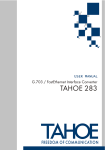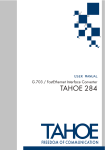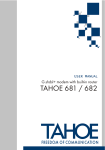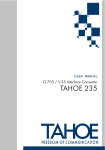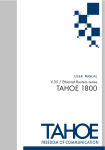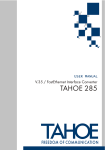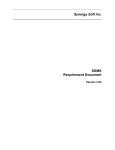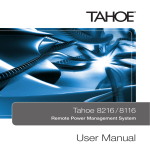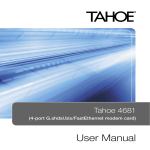Download User manual
Transcript
USER MANUAL G.shdsl+ modem with G.703 interface TAHOE 671 FREEDOM OF COMMUNICATION TABLE OF CONTENTS 1. Introduction ......................................................................... 1 2. Interfaces ............................................................................ 2 3. Modem configuration using built-in keyboard and LCD . 4 4. Configuration using serial console ................................... 10 5. Technical data .................................................................... 12 6. Declaration of Conformity ................................................. 13 i Tahoe® 671 (G.shdsl+ / G.703 modem) User Manual http://www.tahoe-group.com/ Firmware version 1.2.6 ©2004 Tahoe®. All rights reserved. Other trademarks of other companies are used only for explanation and to the owner's benefit, without intent to infringe. Tahoe® assumes no responsibility for any errors or omissions that may appear in this document. Tahoe® makes no commitment to update the information contained here, and may make changes at any time without notice. ii 1 1. Introduction Thank you for purchasing the Tahoe 671 modem. We did our best to ensure highest reliability and performance of our products. Devoting many years of research and development we are proud to provide a superior quality device unfolding new possibilities for the use of the copper lines. Tahoe® 671 is a G.shdsl+ modems allowing data transmission with speeds up to 2048 kbps over a 2-wire line. Thanks to powerful TCPAM-32 modulation throughputs and ranges are much higher than using HDSL technique. TCPAM-16 modulation is also available to provide compatibility with other manufacturers’ products. The modem is equipped with a G.703 interface that may work in both framed or unframed mode. In the first case only selected timeslots may be transmitted over long lines where the throughput of 2048 kbps cannot be achieved. The modem may be managed using a built-in LCD and keyboard, using a serial console or remotely through the DSL line. The system firmware is stored in the Flash memory - it is possible to update it through the serial console. The configuration is stored in the EEPROM memory. 1 2. 2 Interfaces Following connectors are found on the rear panel of the modem: serial console G.shdsl G.703 power connector power switch I O 2.1. 2.1 G.shdsl It is a 6-pin RJ-11 connector used to connect the leased line. The line should be connected to the two central pins (3 and 4). The polarization of a line is not important. Pin 1 2 3 4 5 6 2.2. Function line line - 2.2 Serial console The RS-232 serial console is used for modem management. It has a DB9/M connector and works as a DTE, i.e. a null-modem cable should be used to connect it to a PC. Only three lines (written in bold) are necessary for transmission. Terminal settings are 9600 bps, 8 data bits, 1 stop bit, no parity, no handshaking. Pin 1 2 3 4 5 6 7 8 9 2 Name DCD RXD TXD DTR GND DSR RTS CTS RI Description carrier detect, transmission readiness signaling data received from the PC data sent by the modem to the PC active, when the PC is switched on signal ground active, when the modem is switched on used by the PC to inform that is has data to send used by the modem to permit data transmission ring indicator (signal used in telephone modems) 2.3 2.3. G.703 The G.703 port has a RJ-45 connector. The G.703 standard doesn’t specify the connector pinout, but the pinout used in Tahoe devices is the most common in the industry, thus in most cases a regular straight patch-cord may be used to connect the card to the external device. Anyway the pinout should be carefully checked before connecting the DCE device. The RX+ pin of the card should be connected to the TX+ pin of the other device, the RX- pin to the TX- pin, TX+ to RX+ and TX- to RX-. Pin 1 2 3 4 5 6 7 8 Signal Tx+ TxRx+ Rx- 3 3. Modem configuration using built-in keyboard and LCD The easiest way to configure a modem is to use the four-button keyboard and the LCD. After switching the power on, an information about the modem type, the line throughput and state will be displayed: Tahoe 671 2048 kb/s UC BOOT Four-letter code in the bottom right describes the DSL line state: ¡ ¡ ¡ ¡ BOOT IDLE DOWN SYNC - booting of the G.shdsl transceiver - transceiver inactive - transceiver active, line not synchronized - line synchronized, data may be transmitted The G.703 link status is described using two letters in the upper right corner of the LCD. In case of unframed mode letters “UC” may appear. Letter “U” signals the unframed mode and “C” means that the carrier signal was detected. In the case of unframed mode letters “SC” may appear there. Letter “S” means that the modem is synchronized to the E1 stream. Letter “C” again signals, that the carrier was detected. If only “C” is displayed, then the G.703 signal is present, but the converter is unable to synchronize to it. Perhaps the signal detected is an unframed signal. On the right of the display there is a keyboard with “up”, “down”, “Escape” and “Enter” keys. By pressing up/down buttons you may browse the configuration menu: ¡ ¡ ¡ ¡ ¡ ¡ ¡ ¡ ¡ ¡ ¡ speed setting modem type setting (Master/Slave) line modulation selection CRC4 setting G.703 port line coding, sensitivity and range test loopbacks console throughput language selection storing settings in the EEPROM memory connection reset modem reset Each pressing of the “Escape” button causes the return to the 4 3 primary display with modem type and state. Pressing of the “Enter” button selects given menu option. 3.1 3.1. Throughput setting Line rate: 2048 kb/s (1984) After pressing Enter the throughput may be set using up/down buttons. It may be chosen from 128-2048 kbps range. In the framed mode the first number depicts the DSL line speed, while the second one - a sum of G.703 timeslots used for transmission. It is 64 kbps lower than the first one, because the DS0 synchoronization timeslot is also being transmitted over the DSL line, while it is not used for the data transmission over the G.703 link. When the throughput is set to 2048 kbps (1984) and “up” button is pressed the letters “unfr” will appear in the brackets. It means that the unframed mode is enabled and whole 2048 kbps are used for data transmission. Line rate: 2048 kb/s (unfr) In the framed mode the selection of G.703 timeslots used for data transmission is done automatically depending on the throughput set. Timeslots 0 (synchronization) and 16 (signaling) are selected first, then the subsequent timeslots from 1 to 15 and from 17 to 31: Throughput 128 kbps 192 kbps 256 kbps ... 1024 kbps 1088 kbps 1152 kbps ... 1984 kbps 2048 kbps Timeslots used 0, 16 0, 1, 16 0, 1, 2, 16 ... 0, 1, 2, 3,..., 13, 14, 16 0, 1, 2, 3,..., 13, 14, 15, 16 0, 1, 2, 3,..., 13, 14, 15, 16, 17 ... 0, 1, 2, 3,..., 28, 29, 30 0, 1, 2, 3,..., 28, 29, 30, 31 NOTE: The same throughput must be set on both modems. 5 3.2. Modem type 3.2 Modem type: Master / HTU-C After pressing Enter the modem type may be selected - either Master (HTU-C) or Slave (HTU-R). After selecting the type and pressing Enter again the connection will be reset and renegotiated with new settings. NOTE: Always one modem has to be set as a Master and the other one as a Slave. 3.3. Line coding 3.3 Line coding: 32-TCPAM After pressing Enter the G.shdsl line coding (signal modulation) may be chosen. The number (32 in the example above) means the number of values encoded in one symbol (32 - 5 bits per symbol). The higher this number is, the lower is the signal frequency, which gives better immunity for signal attenuation and higher reach. The second part - PAM or TCPAM - means either the Pulse Amplitude Modulation or Trellis Coded Pulse Amplitude Modulation. The latter is more efficient. It is recommended to use the 32-TCPAM modulation, which provides the best results. The remaining line codings are available to provide compatibility with others’ manufacturers equipment. The 32TCPAM allows throughputs from 256 kbps to 2048 kbps, while 16TCPAM - from 128 kbps to 2048 kbps. The “Auto” setting forces use of 32-TCPAM for speeds higher than or equal to 256 kbps per line and 16-TCPAM for lower rates. 3.4. CRC4 checksum CRC4: on After pressing “Enter” the CRC4 transmission and checking may 6 3.4 be either enabled or disabled. 3.5 3.5. G.703 coding G.703 line code: HDB3 The G.703 port may use one of two available codings - HDB3 and AMI. The first one is used in most cases, the second one is provided for compatibility only. 3.6 3.6. G.703 receiver sensitivity and range G.703 port range 2000m The G.703 port’s receiver sensitivity (thus port range) may be changed - either -12dB (50m) or -43 dB (2000m) 3.7 3.7. Test loopbacks Loopback: disabled The test loopback are useful to diagnose the network problems. Two kinds of loopback are available: ¡ towards DSL - packets received from the G.shdsl line are sent back to it ¡ towards PCM - packets received from the G.703 port are sent back to it 3.8 3.8. Console throughput Console port: 9600 bps Different console port throughputs may be chosen - 9600, 19200 or 38400 bps. Be sure to set the same throughput on the modem and the PC. 7 3.9. Language selection 3.9 Language: English After pressing “Enter” the language used on the LCD and the serial console may be changed. 3.10. Write configuration to EEPROM 3.10 Write config to EEPROM Every change to the configuration will be lost after reboot or power off unless the settings are written to the EEPROM. After reaching this option just press Enter to save them. 3.11. Connection reset 3.11 Connection reset (press Enter) After pressing Enter the G.shdsl link will be disconnected and negotiated again. 3.12. Modem reset 3.12 Modem reset (press Enter) After pressing Enter the whole modem is rebooted. If some settings were not saved to the EEPROM, they will be lost. 3.13. Line parameters The “Esc” button returns to the main screen (with modem type, throughput and link state). While having this screen displayed, you may press Enter to display line attenuation in dB (proper value appears only after the line synchronizes): Line attenuation: 12.5 dB 8 3.13 Pressing Enter again will show so-called Noise Margin (or SignalNoise Ratio). This is the difference between the useful signal and the background noise. It may be used to estimate, how much the line rate may be increased without causing any problems with the synchronization. Noise margin: 6.0 dB When the NMR is less than 0 dB modems will be unable to bring the link up. It is the best practice to keep the NMR equal to or higher than 78 dB, so the error rate will be unnoticeable. Otherwise the packets will be lost due to bit errors and the retransmission would be necessary, thus decreasing the overall effective throughput. Pressing Enter again will return to the main screen with the throughput and modem state. 9 4. console Modem configuration using the serial After connecting the converter to a PC, running a VT-100 terminal emulation software and switching the modem on a menu will appear: main menu G.703 port state log containing most important information about modem status DSL parameters time elapsed since power-on or reboot DSL state firmware version and compilation date Up and down arrows may be used to navigate through the menu. Either Enter or right arrow should be pressed to select an option. To confirm a changed parameter press Enter. To cancel a parameter change press left arrow. All options are identical to the LCD options described in point 3. However two options were added - “Manage remote modem” and “Refresh screen”. 10 4 4.1 4.1. Manage remote modem It is possible to manage the remote modem through the DSL line. First the modems must reach the synchronized state. Then after selecting this option modems will establish a connection in so-called Embedded Operations Channel (EOC, separate from the main data channel). A blinking message will appear on the top of the screen informing that the connection was made. Now all the options on the screen concern the remote modem. They may be changed and stored to the EEPROM. The “Manage remote modem” option will change to “Return to local modem”. Selecting it will cease the remote management. 4.2 4.2. Refresh screen When a working converter is connected to the PC’s serial port the screen contents may be incomplete - selecting this option or pressing Ctrl+L will refresh the screen. 11 5. Technical data 5 ¡ processor: Motorola MC68302 ¡ G.shdsl interface: connector: standards: modulations: RJ-11 ITU G.991.2 (G.shdsl) ITU G.994.1 (G.hs) TCPAM-32, TCPAM-16, TCPAM-8, TCPAM-4, PAM-16, PAM-8, PAM-4, PAM-2 ¡ throughput: 128 - 2048 kbps ¡ G.703 interface: framed according to G.704 or unframed balanced, 120W, RJ-45 connector throughput: 64-1984 kbps or 2048 kbps line coding: AMI, HDB3 signaling: FAS, CCS, CRC4 receiver sensitivity: -12 dB / -43 dB range: 50m / 2000 m ¡ serial console: RS-232, DB9/M connector ¡ dimensions: 200 mm (width) x 45 mm (height) x 130 mm (length) ¡ power supply: 15 V, 230 mA, 3,5W external power supply included ¡ environmental conditions: storage: operation: 12 temperature humidity temperature humidity -20°C to 65°C 5 to 95% 0°C to 40°C 0 to 85% 6 6. Declaration of Conformity TAHOE Piotr Kaczmarzyk ul. Uniwersytecka 1 50-951 Wroclaw, Poland We declare that the product Tahoe 671 complies with the regulations of the following European Directives: ¡ 73/23/EEC ¡ 89/336/EEC ¡ 99/5/EEC low voltage safety requirements EMC requirements radio & telecommunication equipment requirements terminal The compliance of Tahoe 671 with the requirements of the above mentioned directives is ensured by complete application of the following harmonized European Standards: ¡ ¡ ¡ ¡ EN 60950:2000 EN 55022:1998 EN 61000-6-1:2002 EN 61000-6-3:2002 Signed: Position: Piotr Kaczmarzyk Director Signature: Date: Place: 2 Feb 2004 Wroclaw, Poland 13 14 TAHOE® Uniwersytecka 1 50951 Wroc³aw, Poland phone +48 50 100 7362 fax +48 71 344 2642 http://www.tahoe-group.com/




















